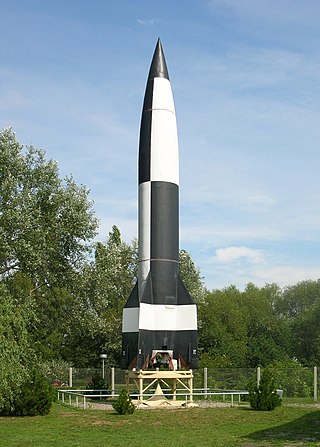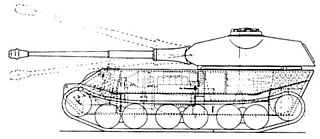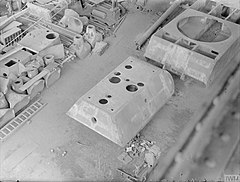
The Tiger II is a German heavy tank of the Second World War. The final official German designation was Panzerkampfwagen Tiger Ausf. B, often shortened to Tiger B. The ordnance inventory designation was Sd.Kfz. 182.. It was also known informally as the Königstiger. Contemporaneous Allied soldiers usually called it the King Tiger or Royal Tiger.

The Kliment Voroshilov (KV) tanks are a series of Soviet heavy tanks named after the Soviet defence commissar and politician Kliment Voroshilov who operated with the Red Army during World War II. The KV tanks were known for their heavy armour protection during the early stages of the war, especially during the first year of the German invasion of the Soviet Union. In certain situations, even a single KV-1 or KV-2 supported by infantry could halt German formations. The German Wehrmacht at that time rarely deployed its tanks against KVs, as their own armament was too poor to deal with the "Russischer Koloss" – "Russian Colossus".

The Panzer II is the common name used for a family of German tanks used in World War II. The official German designation was Panzerkampfwagen II.

Panzerkampfwagen VIII Maus was a German World War II super-heavy tank completed in late 1944. It is the heaviest fully enclosed armored fighting vehicle ever built. Five were ordered, but only two hulls and one turret were completed, the turret being attached before the testing grounds were captured by advancing Soviet military forces.

Nazi Germany developed numerous tank designs used in World War II. In addition to domestic designs, Germany also used various captured and foreign-built tanks.

Wunderwaffe is German word meaning "wonder-weapon" and was a term assigned during World War II by Nazi Germany's propaganda ministry to some revolutionary "superweapons". Most of these weapons however remained prototypes, which either never reached the combat theater, or if they did, were too late or in too insignificant numbers to have a military effect.

The 12.8 cm Selbstfahrlafette auf VK 30.01(H) "Sturer Emil", also called Panzer Selbstfahrlafette V, was an experimental World War II German self-propelled anti-fortification gun. It was based on the Henschel VK 30.01 (H) chassis and armed with a Rheinmetall 12.8 cm Kanone 40 L/61 gun. This gun could traverse 7° to each side, elevate 10° and depress -15°. It carried 15 rounds for the main gun.

This article deals with the tanks serving in the German Army throughout history, such as the World War I tanks of the Imperial German Army, the interwar and World War II tanks of the Nazi German Wehrmacht, the Cold War tanks of the West German and East German Armies, all the way to the present day tanks of the Bundeswehr.

The Tiger I was a German heavy tank of World War II that operated beginning in 1942 in Africa and in the Soviet Union, usually in independent heavy tank battalions. It gave the German Army its first armoured fighting vehicle that mounted the 8.8 cm KwK 36 gun. 1,347 were built between August 1942 and August 1944. After August 1944, production of the Tiger I was phased out in favour of the Tiger II.

The VK 30.01 (P) was the official designation for a heavy tank prototype proposed in Germany. Only two prototype chassis were built. The tank never entered serial production, but was further developed into the VK 45.01 Tiger (P). Porsche called it the Typ (Type) 100.
The VK 45.01 (P), also informally known as Tiger (P) or Porsche Tiger, was a gasoline-electric drive heavy tank prototype designed by Porsche in Germany. Losing to its Henschel competitor on trials, it was not selected for mass production and the Henschel design was produced as the Tiger I. Most of the already produced chassis were rebuilt as Elefant tank destroyers.

The VK 45.02 (P) was the official designation for an unsuccessful heavy tank project designed by Ferdinand Porsche in Nazi Germany during World War II to compete with Henschel's design.
The Vollketten 30 were two series of tank designs by Germany in World War II, originally intended as heavy 'breakthrough' tanks, but later switching completely to designate medium tanks to succeed the Panzer III, IV, and the planned VK 20 series tanks. These were requested in response to the Soviet T-34 and KV-1 tanks, with far heavier armour and armament than the mobile armoured vehicles fielded by the Wehrmacht at the time. Many German companies submitted projects, including Maschinenfabrik Augsburg-Nürnberg (MAN), Daimler-Benz (DB), Henschel, and Porsche. The winning entry tanks would go on to become the famous Tiger I and Panther tanks, capable opponents to the T-34, but it was ultimately too late and at too small of a scale to affect the course of the war.

The VK 30.01 (D) and VK 30.02 (D), were two tank designs made by Daimler Benz submitted for the VK 30 project for a 30 tonne tank to be used by the German army.

The VK 30.01 (H) is a German prototype heavy tank developed by Henschel in Germany during World War II. It was rejected for production likely due to being outdated by the time it was meant to be produced. The chassis from this project went on to form the chassis for the Sturer Emil self-propelled anti-tank gun project.
VK 45.01 (H) was a German tank which was the final prototype of the Panzer VI Tiger I, evolved from the VK 36.01 (H), designed by Henschel. It was selected by Adolf Hitler over the competing VK 45.01 (P) from Porsche for production into the Tiger I. It came in two variants, the VK 45.01 (H) H2 with a 75 mm L/70 gun, and the VK 45.01 (H) H1 with an 88 mm L/56 gun.















